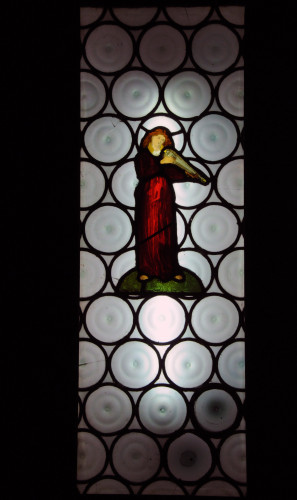This window is one of a pair (see C221ii) made for The Grange, the home of Edward and Georgiana Burne-Jones built from November 1867.
The minstrel figures are from a set of twelve designed by William Morris in the mid-1860s. They were also used for painted tiles (e.g. for Novello & Co.’s shop in Berners Street, now in the V&A Museum) and, with the addition of wings, as Minstrel Angels in many church windows (e.g. at Furneaux Pelham Church, Hertfordshire). Since the figures in the Grange window are identical in size to those used for two tile panels, it seems likely that the cartoons were made directly from the tile drawings.
The ’round glass’ surrounding the figures is made of cast discs manufactured to simulate the appearance of spun glass roundels. This type of glazing, often seen in room interiors in 15th century Netherlandish paintings (e.g Jan Van Eyck’s Arnolfini Wedding), was a favourite motif in the Morris firm’s stained glass. Also notable is the use of ‘spolit ruby’ glass, with its swirling, ireegular, red colouring for the robe of the right-hand Minstrel.
A photograph (1887) by Frederick Hollyer and a watercolour (1898) by T.M. Rooke, both show the windows in situ in the Burne-Jones’s house. After Edward Burne-Jones’s death in 1898, the glass was re-installed at the family’s house in Rottingdean (1904/5), from where it was removed in the 1970s.

